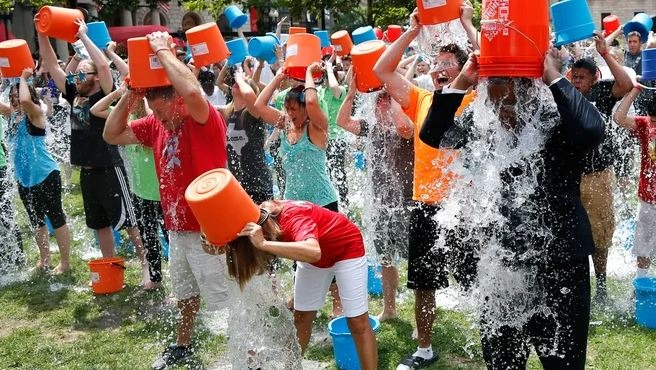Do You Know Why the Ice Bucket Challenge Made a Powerful Comeback This Year
The Ice Bucket Challenge is back in 2025, sparking global attention once again! Discover its powerful comeback, stories, and impact on ALS awareness and fundraising.
ENTERTAINMENT & SPORTS
Do You Know Team
8/6/20253 min read


In 2014, millions around the world poured ice-cold water over their heads, shared videos online, and challenged their friends — all for a cause: raising awareness and funds for ALS (Amyotrophic Lateral Sclerosis). It became one of the biggest viral charity movements in history, raising over $220 million globally.
Fast-forward to 2025, and the Ice Bucket Challenge has made a powerful return, reigniting conversations, social media feeds, and most importantly, charitable donations. This time, it’s not just nostalgia — it’s bigger, more personal, and technologically smarter.
1. The Original Impact Still Echoes
The first wave of the Ice Bucket Challenge in 2014 was revolutionary. Celebrities, sports stars, politicians, and everyday people participated, bringing ALS into global focus. This massive awareness led to breakthrough research that helped discover new genes linked to ALS.
Even after the original trend faded, the emotional connection remained. Many who participated in 2014 still remember the thrill of joining a movement that actually saved lives.
2. 2025’s Perfect Timing for a Revival
The comeback in 2025 is not random. Organizers aligned it with new research milestones in ALS treatment. Earlier this year, scientists announced a promising experimental therapy showing signs of slowing disease progression by 30% in early trials.
This success story gave the challenge a fresh, hopeful narrative — it’s no longer just about awareness, but also about funding a possible cure.
3. Personal Stories Driving the Movement
The real fuel for the comeback is deeply personal. For example:
Michael James, a 35-year-old teacher from the UK diagnosed with ALS in 2019, credits early research funded by the original challenge for extending his mobility. His emotional 2025 Ice Bucket video went viral, garnering 12 million views in a week.
In India, college student Rhea Kapoor revived the challenge on her campus after losing her uncle to ALS, raising over ₹12 lakh in just ten days.
These human stories resonate far more than statistics alone — making participation a heartfelt act, not just a viral stunt.
4. Social Media Evolution Supercharged the Trend
In 2014, Facebook and Twitter dominated. In 2025, the challenge thrives on Instagram Reels, TikTok, YouTube Shorts, and live-streaming platforms. Augmented reality filters now simulate ice water effects for those unable to do the physical challenge — making it inclusive for people with medical restrictions.
Hashtags like #IceBucket2025 and #FreezeALS are trending globally, generating over 1.4 billion views in the first month.
5. Corporate Partnerships Boost Fundraising
Large brands have joined forces in creative ways:
Sports drink companies donate ₹50 for every challenge video tagged with their brand.
Streaming platforms feature “ALS Week,” where ad revenue supports research.
This partnership approach has already raised $75 million in the first quarter of 2025, surpassing early 2014 figures.
6. Data-Driven Philanthropy
Unlike in 2014, modern donation platforms track the exact impact of funds in real time. Participants receive monthly updates on how their contributions are helping. For example, donors can see progress reports from ALS research labs, making their support more transparent and rewarding.
7. Critics and Counterpoints
Some critics argue that reviving old challenges dilutes originality. Others worry about “slacktivism,” where people post videos without donating. However, statistics show that in 2025, 83% of participants have also made a donation — a significant increase from 69% in 2014.
8. Global Adaptations
Countries have put their own spin on the challenge:
In Japan, participants use ice tea instead of water to conserve fresh water resources.
In Africa, some communities are using symbolic water-pour events while raising funds for ALS and local clean water projects simultaneously.
This adaptability keeps the campaign culturally relevant while broadening its impact.
FAQs
Q1: What is the Ice Bucket Challenge?
It’s a viral activity where people pour ice-cold water over themselves to raise awareness and funds for ALS research.
Q2: Why did it come back in 2025?
A major breakthrough in ALS treatment and the emotional connection from the 2014 campaign reignited global interest.
Q3: How much money has it raised this year?
As of mid-2025, the revived challenge has raised over $75 million worldwide.
Q4: Do I have to pour ice water to participate?
No. AR filters, symbolic events, and even digital challenges make it inclusive for everyone.
Q5: How can I donate?
Through official ALS research websites or verified fundraising platforms promoted during the campaign.
Conclusion
The 2025 revival of the Ice Bucket Challenge proves that a powerful cause never truly fades. By combining emotional storytelling, cutting-edge technology, and global solidarity, it has once again turned an online trend into real-world impact. The challenge reminds us that when people unite with purpose, even something as simple as a bucket of ice water can help change the world.
#IceBucketChallenge2025, #FreezeALS, #ALSResearch, #CharityChallenge, #ViralForGood, #DoYouKnowFacts, #Fundraiser2025, #GlobalChallenge, #HopeForALS
Knowledge
Empowering minds with reliable educational content daily.
Newsletter Signup
© 2025 DoYouKnow. All rights reserved.
Stay Ahead of the Trends – Join Our Newsletter
